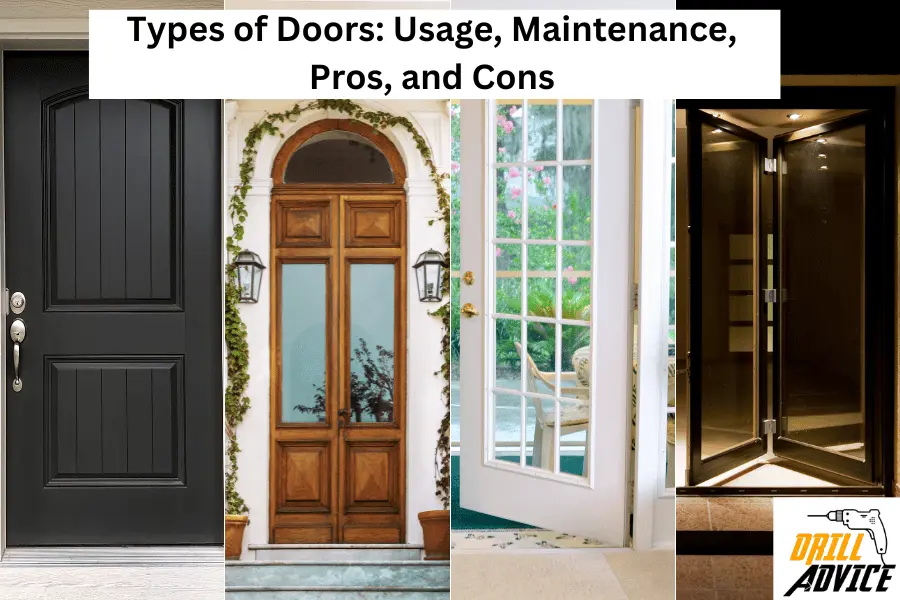
The door is a moveable barrier that is used to cover an opening in a wall. The doors are different in type according to their material, usage, structure, geological conditions, and purpose. The 11 most used types of doors are single-leaf, double-leaf, half-glass, bypass sliding, arcadia sliding, telescopic sliding, inswing French, outswing French, multipanel doors, louvered bi-fold doors, and glass panel doors. These doors are made with different types of materials, such as wood, glass, metal, and composite materials.
Doors should be maintained properly by applying suitable lubricants, cleanings, alignment checking, and applying necessary sealing and coatings in order to increase the service life of the door. Each door type has advantages and disadvantages. Before choosing a door type, you should consider the purpose of the door, material type, size, dimensions, style, and aesthetic appeal. Budget, energy efficiency, security, insulations, installation, maintenance, accessibility, resistance, brand and warranty of the door.
What are the 11 Types of Doors?
The 11 Types of Doors are;
- Single Leaf Door
- Double Leaf Door
- Half-Glass Door
- Bypass Sliding Doors
- Arcadia Sliding Doors
- Telescopic Sliding Doors
- Inswing French Doors
- Outswing French Doors
- Multi-panel French
- Louvered Bi-Fold Door
- Glass Panel bi-fold
1. Single Leaf Door
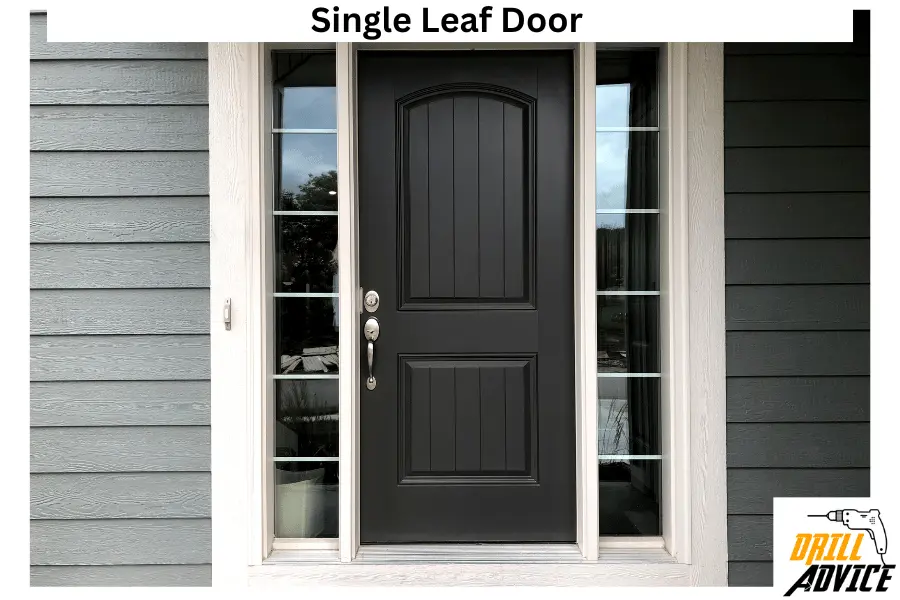
A single-leaf door is a door that consists of a single panel that fills the doorway and swings open either inward or outward. Single-leaf doors are versatile and can be used in various settings, including bedrooms, bathrooms, offices, and entrances to buildings.
Maintenance of Single Leaf Door
- Regular cleaning with a suitable cleaner for the material.
- Should be lubricated periodically for smooth operation.
- Regular checks are needed for wear and tear, including potential issues with the lock mechanism.
- Need weather sealing to prevent drafts.
Advantages of Single Leaf Door
- Easier to install and maintain single-leaf doors due to a straightforward design.
- Available in various styles and materials to suit different interiors.
- More affordable compared to complex door systems.
- Offer better security with proper locking mechanisms.
Disadvantages of Single Leaf Door
- Requires sufficient space to swing open.
- Limited aesthetic appeal.
- Causing congestion in busy areas.
- Not consist of the best sound insulations.
2. Double Leaf Door
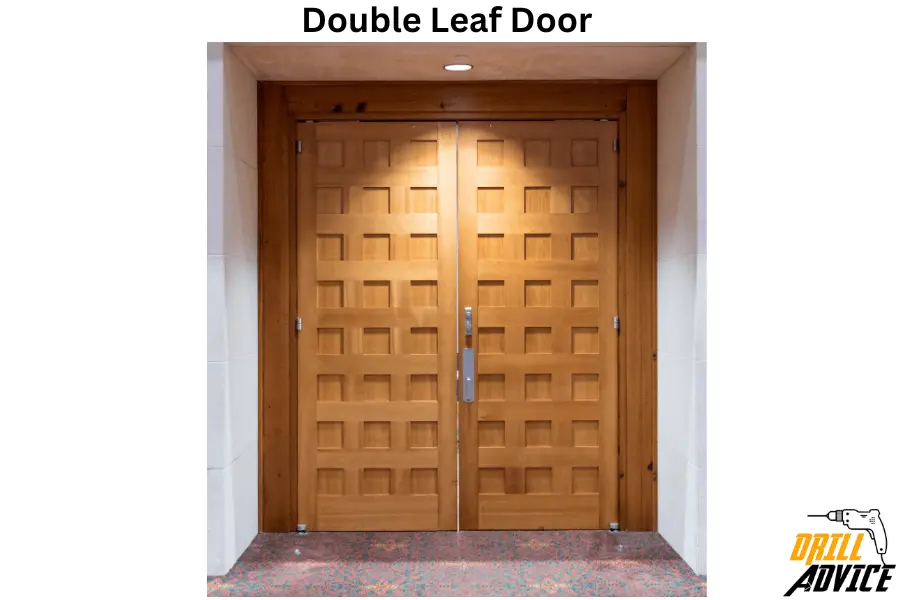
A double-leaf door consists of two door panels that meet in the middle of the door frame. These panels can open simultaneously or separately. It provides a larger opening compared to a single-leaf door. Double leaf doors are often used in entryways of commercial buildings, large residential properties, and in rooms that require wider access such as conference rooms or banquet halls.
Maintenance of Double Leaf Door
- Double-leaf doors require regular cleaning.
- Hinges should be lubricated to prevent squeaking and wear.
- Frequently check the alignment to ensure smooth operation.
- Maintain weather stripping to prevent drafts and energy loss.
Advantages of Double Leaf Door
- Double-leaf doors have wider access.
- Improve the aesthetic appeal
- Flexible Usage: Double-leaf doors can use one leaf for regular access and both when needed.
- Improved Ventilation: Double-leaf doors can open both leaves to allow better airflow in a space.
Disadvantages of Double Leaf Door
- More expensive due to additional materials and the complex installation process.
- Requires more maintenance as it involves double the components of a single-leaf door.
- Potentially less secure, especially if the locking mechanism is not robust.
- Requires more space for installation and operation compared to single-leaf doors.
3. Half-Glass Door

A half-glass door is a door where the upper half is made of glass. It allows visibility and light passage, while the lower half is constructed of a solid material, offering privacy and security. Half-glass doors are typically used in offices for private cabins or meeting rooms, in residential settings for back doors or patio doors, and in commercial settings like shops and restaurants to offer a view inside.
Maintenance of Half Glass Door
- Needs regular cleaning.
- Maintenance of the solid part depends on the material (wood, metal), which might include painting or polishing.
- Periodic inspection of the seals around the glass to prevent moisture ingress.
- Regular lubrication and tightening of hinges to ensure smooth operation.
Advantages of Half-Glass Door
- Allows more natural light into the space, promoting energy savings.
- Enhance the visual appeal of the space with a modern and open look.
- Improve the level of visibility, fostering a sense of openness and connection to adjoining spaces.
- A wide range of styles and designs are available to complement different architectural styles.
Disadvantages of Half-Glass Door
- Decrease the privacy due to glass panel
- Less security due to the glass section
- Temperature fluctuations
- Require regular maintenance and cleaning.
4. Bypass Sliding Doors
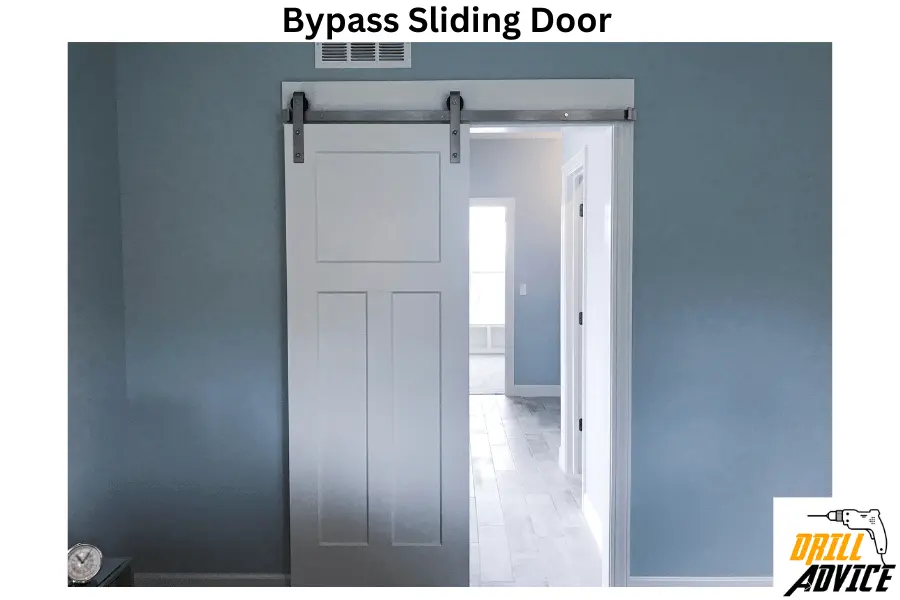
Bypass sliding doors are doors that consist of two or more panels that slide horizontally along parallel tracks, allowing them to slide over one another to open or close. These doors are commonly utilized in closets, laundry rooms, or as room dividers.
Maintenance of the Bypass Sliding Doors
- Need to keep the tracks clear of dust and debris to ensure smooth sliding.
- Require periodically lubricating the tracks to reduce friction.
- Alignment should be checked to prevent derailing.
- If it has glass panels, clean them regularly to maintain transparency and aesthetics.
Advantages of the Bypass Sliding Doors
- Space-Saving: Bypass sliding doors does not require swing space, making them ideal for compact areas.
- Easy Access: Bypass sliding doors provides easy access to the contents of a closet or room.
- Aesthetic Variety: Bypass sliding doors are available in various styles and materials to match interior decor.
- Easy Installation: Bypass sliding doors are easy to install compared to other door types.
Disadvantages of the Bypass Sliding Doors
- Limited Access: Bypass sliding doors can only access one section of the closet or space at a time.
- Track Issues: The tracks can accumulate dirt and require regular cleaning and maintenance.
- Overlapping Panels: The overlapping panels can sometimes obstruct the view or access to the interior.
- Sound Insulation: Bypass sliding doors offer limited sound insulation compared to solid, hinged doors.
5. Arcadia Sliding Doors
Arcadia sliding doors are large glass doors that slide horizontally. Arcadia sliding doors are used to provide a wide and clear view of the outside, usually connecting interiors to patios or gardens. These doors are commonly used in residential homes for areas leading to patios, backyards, or balconies and in commercial spaces such as hotels or office buildings to offer a panoramic view and access to outdoor spaces.
Maintenance of Arcadia Sliding Doors
- Regular Glass Cleaning: Arcadia sliding doors require regular cleaning of the glass panels to maintain transparency.
- Need Track Maintenance: Ensure the tracks are clean and free of obstructions for smooth sliding.
- Regularly check and replace the weather stripping to prevent air leaks.
- Lubricate the sliding mechanism occasionally for smooth operation.
Advantages of Arcadia Sliding Doors
- Provides broad, uninterrupted views of the outside area.
- Arcadia sliding doors allows natural light
- Space Saving: The sliding mechanism saves space as they do not swing open into the room.
- Indoor-Outdoor Connection: Creates a seamless connection between indoor and outdoor spaces, which can be particularly beneficial in scenic locations.
Disadvantages of Arcadia Sliding Doors
- Frequent cleaning: The large glass panels of the Arcadia sliding doors require frequent cleaning to maintain the view.
- Weak security: These can be a potential weak point for security, as they may be easier to breach compared to solid doors.
- Less energy efficiency: Large glass areas can result in heat loss during winter and heat gain during summer, affecting energy efficiency.
- Higher cost: Arcadia sliding doors can be more expensive compared to standard doors due to the large glass panels and the specialized installation required.
6. Telescopic Sliding Doors
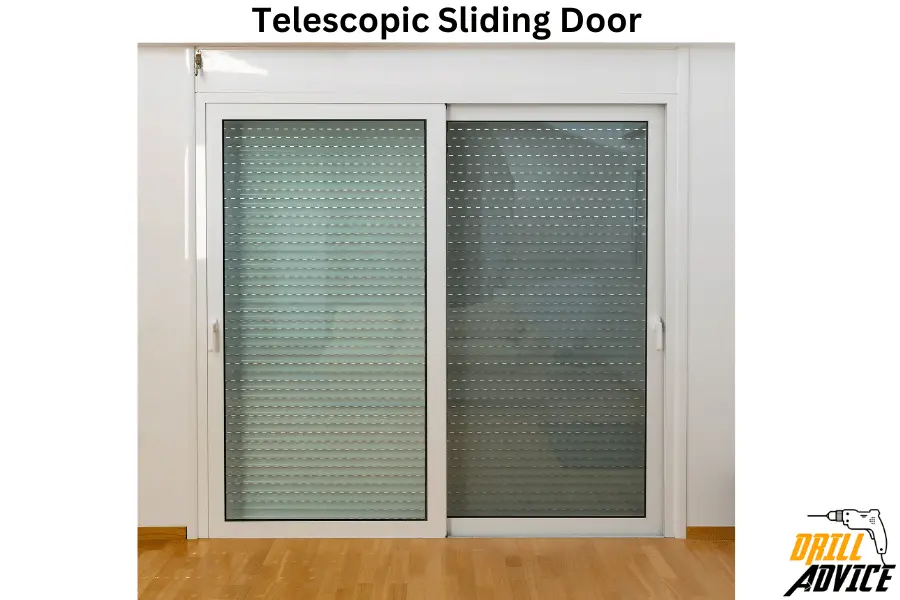
Telescopic sliding doors comprise multiple sliding door panels that open and close in a synchronized manner. Telescopic sliding doors provide a wider opening compared to standard sliding doors, as the panels slide over one another, conserving space. These doors are often used in commercial spaces like malls, hotels, and office buildings where wide entrances are required.
Maintenance of Telescopic Sliding Doors
- Regularly clean the tracks to remove dust and debris.
- Lubricate the tracks and mechanisms to ensure smooth operation.
- Sensor Maintenance: If equipped with sensors, ensure they are functioning correctly to prevent accidents.
- Alignment Checks: Regular checks to ensure that the doors are aligned correctly to prevent jams or uneven wear.
Advantages of Telescopic Sliding Doors
- Telescopic sliding doors allow for a larger opening, facilitating the movement of large items or groups of people.
- Space-Saving: Telescopic sliding doors save more space compared to traditional swinging doors.
- Modern Appearance: Telescopic sliding doors offer a sleek and modern appearance, enhancing the aesthetic of the space.
- Customizable: Can be customized in various designs and materials to suit the architectural style of the building.
Disadvantages of Telescopic Sliding Doors
- Complex mechanism – The mechanism is more complex compared to standard sliding doors, potentially leading to more frequent maintenance issues.
- Precise Installation – Requires precise installation to ensure that the synchronized movement functions correctly.
- More Expensive – Telescopic sliding doors are more expensive due to the complexity of the system and the number of panels used.
- Partial Blockage – Even when fully open, some portion of the doorway will be blocked by the stacked door panels.
7. Inswing French Doors
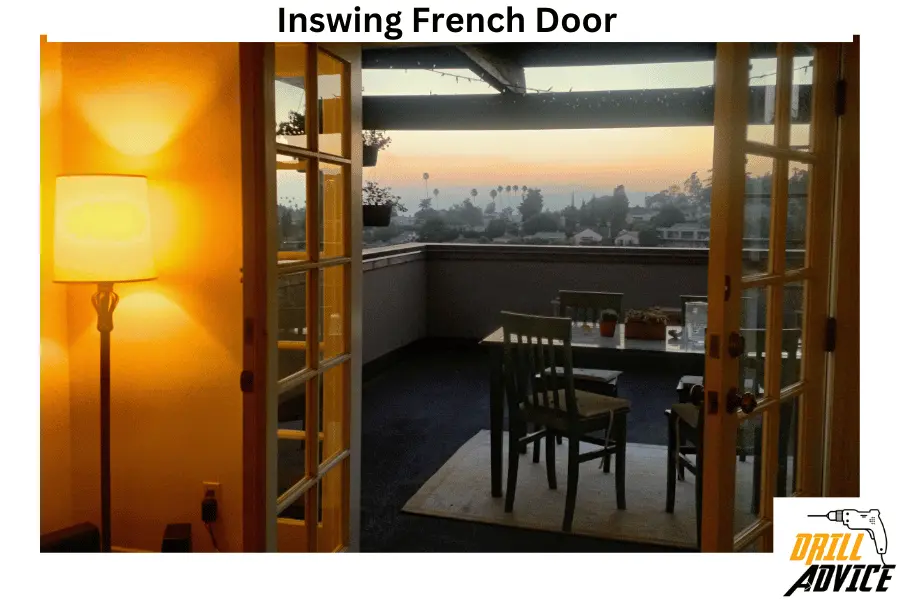
Inswing French doors are a pair of doors that have glass panels extending for most of their length and swinging inward. Inswing French doors are usually opening from the center. Inswing French doors are typically used in residential settings as entry doors to patios, gardens, or balconies and sometimes as interior doors separating two rooms while allowing a visual connection and the passage of light.
Maintenance of the Inswing French Doors
- Regularly check the inswing french door and lubricate the hinges to prevent squeaking and wear.
- Maintain the cleanliness of the glass panels for clear visibility and aesthetic appeal.
- Check and replace weather stripping to ensure energy efficiency and prevent water ingress.
- Regularly inspect inswing french door lock mechanisms to ensure security.
Advantages of the Inswing French Doors
- Aesthetically Pleasing: Inswing French doors often add a stylish and elegant touch to the space with their classic design.
- Receive Natural Light: Glass panels allow a significant amount of natural light into the space.
- Versatile Design: Available in various designs, materials, and finishes to suit different architectural styles.
- Indoor-Outdoor Connection: Inswing French doors can create a seamless connection between indoor and outdoor spaces.
Disadvantages of the Inswing French Doors
- Additional Space Requirement: Inswing French doors require sufficient free space inside to open fully.
- Weak Security: Glass panels can potentially be a weak point in terms of security.
- Less Energy Efficiency: Inswing French doors do not offer the best insulation due to the presence of large glass panels.
8. Outswing French Doors
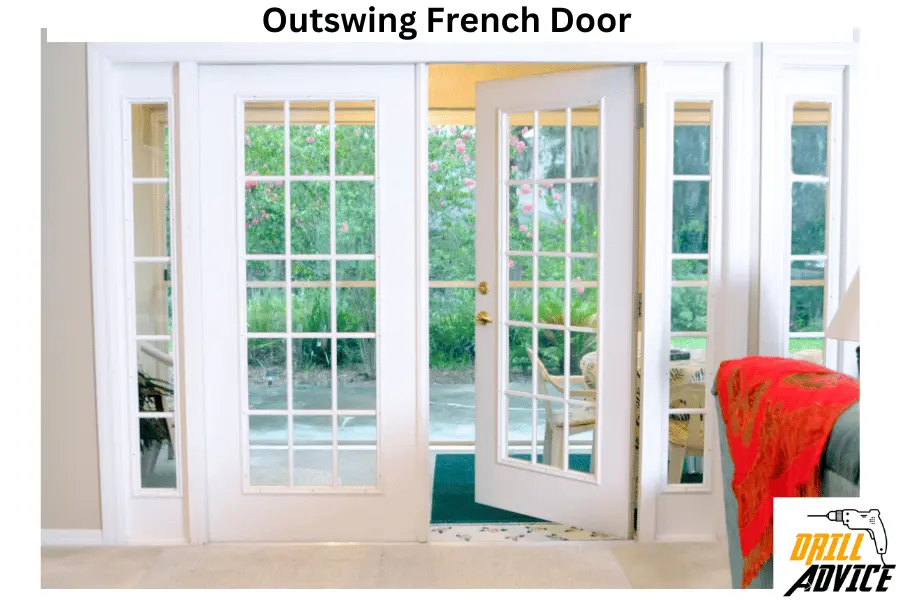
Outswing French doors are a type of door system consisting of two doors with glass panels that open outward, usually from the center. This conserves interior space. These doors are typically used in homes and commercial buildings as exits to gardens, patios, and balconies.
Maintenance of Outswing French Doors
- Regularly lubricate the outswing French door hinges to prevent rust and ensure smooth operation.
- Frequent clean outswing French door glass panels to maintain clarity and aesthetics.
- Regular inspection and replacement of the outswing French door seals around the doors to prevent water and air infiltration.
Advantages of Outswing French Doors
- Space Saving: Outswing French door does not require interior space to operate, making them suitable for rooms with limited space.
- Wind Resistance: Outswing French doors can be more resistant to strong winds, as the wind helps in keeping the door closed rather than forcing it open.
- Improved Ventilation: The outswing French door allows for maximum ventilation and natural light due to the wide opening facilitated by double doors.
Disadvantages of Outswing French Doors
- Require Exterior Space: Requires sufficient exterior space to swing open fully.
- Vulnerability to Weather: Being exposed to the outside, the door might be more susceptible to adverse weather conditions.
- Less Security: The hinge pins are on the outside, which could potentially be a security concern, though many designs have features to mitigate this.
- Obstruction: Can obstruct pathways or external areas when open, and can potentially be damaged by strong winds if not secured properly.
9. Multi-panel French Door

Multi-panel French doors consist of more than two door panels, often with glass inserts, that can either swing or slide open. Multi-panel French doors provide a wide, flexible opening while maintaining a classic aesthetic. Multi-panel French doors are generally used in residential and commercial properties where a large opening is desired to connect indoor spaces with outdoor areas such as gardens, patios, or balconies.
Maintenance of Multi Panel French Door
- Glass Cleaning: Clean the glass panels regularly to maintain transparency and a neat appearance.
- Lubrication: Apply lubricant to the hinges or tracks periodically for smooth operation.
- Seal and Weather Stripping: Inspect and replace seals and weather stripping as needed to prevent air and water infiltration.
- Alignment Checks: Regularly check the alignment of the doors to ensure proper functioning and to prevent uneven wear.
Advantages of Multi-Panel French Door
- Provides wide, uninterrupted views and a significant influx of natural light.
- Flexible Opening: Allows for a flexible and large opening.
- Adds an elegant and classic touch to the property, enhancing its aesthetic value.
- Indoor-Outdoor Connectivity: Facilitates a seamless connection between indoor and outdoor spaces, ideal for entertaining and enjoying scenic locations.
Disadvantages of Multi-Panel French Door
- Complex Installation: The installation and mechanism can be more complex compared to standard doors, possibly leading to higher initial costs.
- Require more Maintenance: Requires more maintenance due to the increased number of panels and parts.
- Space Requirements: Depending on the type (swinging), it might require considerable space to operate fully.
- Potential for Air Leaks: Having multiple panels can increase the potential for air leaks and decrease energy efficiency if not sealed properly.
10. Louvered Bi-Fold Door

Louvered bi-fold doors are doors made up of slats that are mounted in a frame and can fold in pairs. These slats are often angled to allow ventilation while also providing a barrier to debris and direct sunlight. Louvered bi-fold doors are usually used in areas requiring improved ventilation along with privacy, like laundry rooms, closets, or pantries.
Maintenance of Louvered Bi-Fold Doors
- Louvered bi-fold doors are regular dusting due to the slats.
- Louvered bi-fold doors need occasional lubrication for smooth functions.
- Louvered bi-fold doors need periodic refinishing or repainting.
- Louvered bi-fold doors need regular Inspection for smooth movements and alignments.:.
Advantages of Louvered Bi-Fold Doors
- Louvered slats allow for better air circulation.
- Louvered bi-fold doors can save space due to their bi-folding nature.
- Louvered bi-fold doors offer privacy while still allowing airflow.
- Louvered bi-fold doors have a versatile design.
Disadvantages of Louvered Bi-Fold Doors
- Louvered slats can accumulate dust easily hence need frequent cleaning.
- Louvered bi-fold doors has limited insulation.
- More complex to construct and install compared to simple flat doors.
- Susceptible to damage, and repairs can be complicated.
11. Glass Panel bi-fold
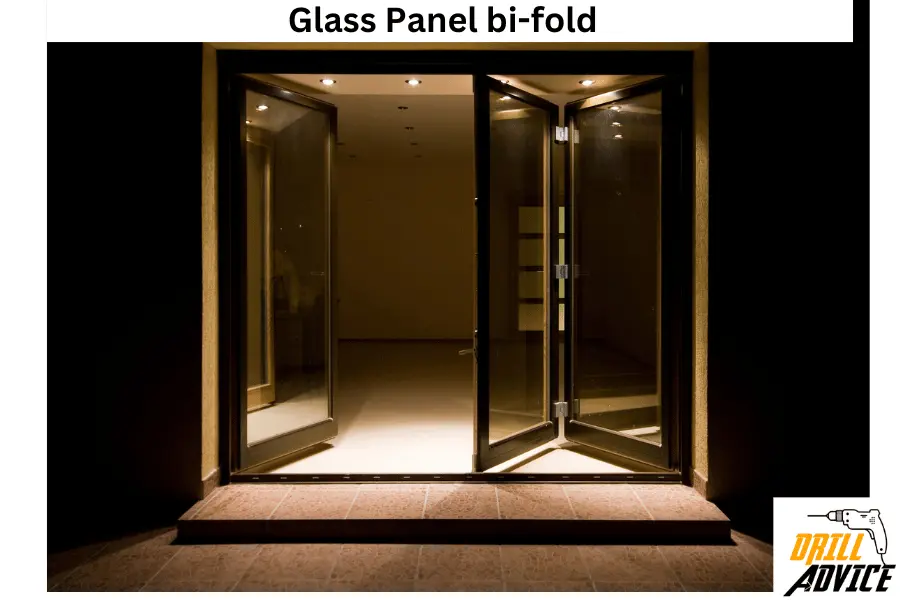
Glass panel bi-fold doors are doors consisting of multiple panels with glass inserts that are hinged together. Glass panel bi-fold doors allow for folding onto themselves when opened, providing a wide unobstructed view and access to adjacent spaces. Glass panel bi-fold doors are popular in residential and commercial settings. They are used to separate interior spaces or to connect an interior space with an outdoor area like a patio, garden, or balcony, providing a seamless transition between indoor and outdoor environments.
Maintenance of Glas Panel Bi-Fold Doors
- Regular cleaning of the glass panels is necessary to maintain clear views and aesthetic appeal.
- The tracks should be kept clean and clear of debris to ensure smooth operation.
- Periodic lubrication of the hinges to facilitate smooth folding and unfolding.
- Regular inspection and replacement of seals to prevent air and water leakage.
Advantages of Glas Panel Bi-Fold Doors
- Allow Natural Light: Allows a large amount of natural light to enter the space, enhancing the brightness and ambience.
- Expansive Views: Provides expansive, unobstructed views of the outside when fully opened.
- Space Saving: The bi-fold mechanism saves space as it requires less swing area compared to traditional doors.
- Aesthetic Appeal: Glass panel bi-fold doors add a modern and luxurious touch to the property, enhancing its aesthetic value.
Disadvantages of Glas Panel Bi-Fold Doors
- More expensive due to the complex mechanism and the use of glass panels.
- Requires regular maintenance to keep the glass clean and the folding mechanism working smoothly.
- Less Security: Glass panels can potentially be a weak point in terms of security, as they might offer easier access for intruders than solid doors.
13 Things to Consider Before Choosing a Door Type?
Before choosing a door type, you should consider the purpose of the door, material type, size, dimensions, style, and aesthetic appeal. Budget, energy efficiency, security, insulations, installation, maintenance, accessibility, resistance, brand and warranty. If you consider all the above things, you can choose a higher quality and durable door type according to your personal requirements. These are the in-detailed considerable things related above factors.
- Purpose of the Door: Before you choose a door type, you should consider where the door will be installed and its primary function. For instance, front doors need to be secure and durable, while interior doors might prioritize style or sound insulation.
- Suitable Material Type: When you choose a door, you should consider the material type. According to the material types, its price, workability, soundproofness, thermal conduction, aesthetic appeal, and durability can be changed. You can choose these door material types such as Wood which is classic and versatile. Steel offers high security, fiberglass is durable and energy-efficient, and glass can provide a modern look and natural light.
- Proper Size and Dimensions: You should consider the size and dimensions of the door. The main door should be larger than other types of doors. Bathroom doors can be the smallest doors. Other doors should be large enough in size as occupants move easily.
- Attractive Style and Aesthetics: You should pay attention to the style of the door. Style and aesthetic appeal should complement the overall architecture and interior design of the space. It should match the color, texture, and panel designs.
- Affordable Budget: The door price is, depending on the material, design, and features. Hence your selected door should match your expectations for quality and aesthetics.
- High Energy Efficiency: The door should have a better energy efficiency. The door should have proper thermal insulation. This is important in the winter season. Before choosing a door make sure the door has properly insulated for thermal heating. In order to improve the efficiency you can install a weatherstripping to seal the gap around the door.
- Higher Security: Before you choose the door, you should consider doors with a proper lock and materials that are hard to break..
- Ease of Maintenance: Your chosen door should be less maintenance and cleaning. Because some doors require frequent maintenance and cleaning most of door parts. When you choose a wood door it might need regular sealing or painting, and fiberglass and steel doors might require less upkeep.
- Easy of Installation: Consider the complexity of the installation process. Some doors might require professional installation, adding to the cost.
- Disable Accessibility: When you choose a door, you should consider how easily a disabled can access through the door. Your selected door should be opened and closed easily by the disabled at any time.
- Weather Resistance: When you choose an exterior door such as a garage door you should consider its weather resistance. When the doors are open to water and moisture, it will be water-damaged such as corrosion, warping and fading.
- Higher Sound Insulation: Higher insulated doors are good for the higher noise level areas. If you choose a door for your workspace, you should choose a higher sound-insulated door.
- Warranty: When you choose a door type, you should consider the door brand and warranty. By checking these 2 you can have a better idea about the durability and maintenance easily. Higher warranty doors are better than less warranty doors.
